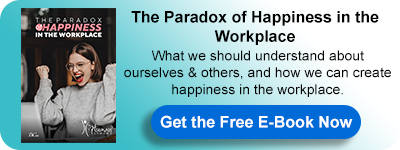Engaged Mental State at Work
Dave Dave, lift your head up
Dave Dave, come on look at us
Dave is just in another world
While everyone else might seem bored
Dave is flowing with what he does
Not caring at all with office buzz
For Dave is in an engagement state
While others have jobs they simply hate
Look and learn a lot from Dave
Yes, of his happiness, everyone is in rave
Engagement, according to Seligman, is in line with the FLOW concept developed by Csikszentmihalyi (1989). It includes the loss of self-consciousness by being wholly absorbed in an activity while focusing entirely on the task at hand.
"Enjoyment appears at the boundary between boredom and anxiety, when the challenges are just balanced with the person's capacity to act." ― Mihaly Csikszentmihalyi. According to this quote, reaching engagement happens when finding the perfect combination of challenge and strengths or skills1.
On the International Week of Happiness, let's explore how organizations can help employees get more engaged, which positively reflects on their happiness levels.
How should organizations help employees reach a more engaged state of mind?
According to Csikszentmihalyi, reaching a flow state depends on utilizing employees' skills and talents to effectively accomplish a task or challenge. Therefore, organizations need to encourage employees to uncover their strengths and put them into use.
Accordingly, organizations can work on the below to help employees reach high levels of engagement:
1. Invest time and effort to understand employee strengths
Some assessments that help identify areas of strengths could come in handy. Investing money in some of those will help employees become more aware of their areas of strengths and skills. In addition, this will enhance management realize and understand the strengths of their employees.
2. Design jobs and tasks around employee capacity
Being aware of employee strengths needs to be followed by action. Tasks need to be designed around manpower capabilities, thus promoting daily practice of talents. Moreover, conveying clear set goals to employees. These two actions should stimulate a flow state, leading to satisfaction and happiness.
3. Offer feedback
To close the loop, efforts should always be followed by constructive feedback to enhance understanding. Feedback eventually reflects on the expectations from the employees as they see themselves progress and learn.
4. Promote autonomy
Employees need a certain amount of freedom to do their jobs. Giving employees high levels of control over their jobs helps increase their ownership & accountability2.
1Melissa Madeson 2021, Positive Psychology, Accessed 20 Jul 2021, https://positivepsychology.com/perma-model/
2Meng Li 3/7/2020, How to Create Flow States at Work, Ohio State University, Accessed 20 Jul 2021, https://fisher.osu.edu/blogs/leadreadtoday/blog/how-to-create-flow-states-at-work
For more about this topic, download our latest book " The Paradox of Happiness in the Workplace " for FREE:
